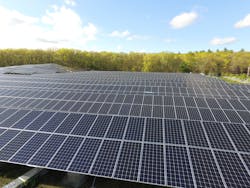Wahoo Utilities Solar Project Energized and Benefiting the Wahoo Public Library in Nebraska
The Wahoo Utilities solar project in Wahoo, Nebraska, has been energized, with the proceeds of the contracted land lease set to fund the Wahoo Public Library.
Wahoo Utilities has leased 10 acres near its substation for the project, with payments directed to a trust benefiting the Wahoo Public Library, where Denise Lawver - the landowner - is the director.
A partnership between GenPro Energy Solutions, Sol Systems, Mesner Development, and Wahoo Utilities, the project features 6,534 solar panels and a capacity of 2 MW AC, enough to power approximately 350 homes a year. Development began in 2020, and the project was approved for construction in 2022.
The project and hydroelectric power from the Western Area Power Administration (WAPA), combined with the nuclear and other clean energy resources of the Nebraska Public Power District (NPPD), allows Wahoo Utilities to have a balanced electric generation mix between carbon-free and traditional energy resources.
"The main benefit of this project and partnership was affordable power very closely priced to what we buy our blended power from the NPPD," said Ryan Hurst, General Manager of Wahoo Utilities. "The 30-year contract on this Purchase Power Agreement was a way to hedge a portion of our power portfolio affordability for the next 30 years."
About the Author
EnergyTech Staff
Rod Walton is senior editor for EnergyTech.com. He has spent 17 years covering the energy industry as a newspaper and trade journalist.
Walton formerly was energy writer and business editor at the Tulsa World. Later, he spent six years covering the electricity power sector for Pennwell and Clarion Events. He joined Endeavor and EnergyTech in November 2021.
He can be reached at [email protected].
EnergyTech is focused on the mission critical and large-scale energy users and their sustainability and resiliency goals. These include the commercial and industrial sectors, as well as the military, universities, data centers and microgrids.
Many large-scale energy users such as Fortune 500 companies, and mission-critical users such as military bases, universities, healthcare facilities, public safety and data centers, shifting their energy priorities to reach net-zero carbon goals within the coming decades. These include plans for renewable energy power purchase agreements, but also on-site resiliency projects such as microgrids, combined heat and power, rooftop solar, energy storage, digitalization and building efficiency upgrades.
